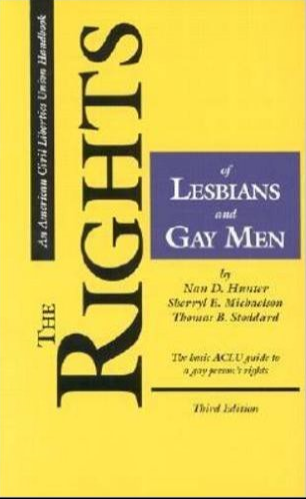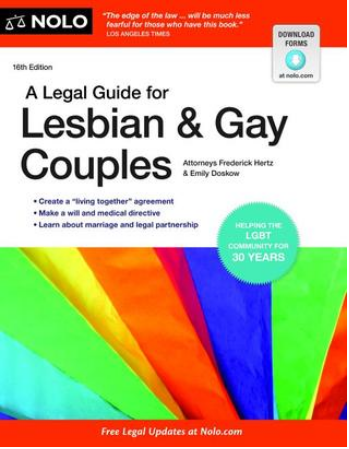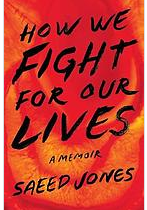Off the Shelf #5: Now That We’re Legal: The Literature of LGBT Civil Rights Advice
by Rob Ridinger
The Supreme Court decision of June 26, 2015 legalizing same-sex marriage in all fifty states marks a huge step forward in the struggle for LGBT people to achieve social and legal equality with their fellow Americans. Along the way, battles over everything from child custody to employment and housing have generated a body of literature (accessible both in print and online) whose history is worth examining as we move ahead.
 One of the first books that many LGBT people coming out would have encountered which addressed the concept that they had civil rights protections under existing American laws was The Rights of Gay People : The Basic ACLU Guide to a Gay Person’s Rights, whose first edition appeared as a paperback in 1975. The authors’ introduction is worth reading as a window into the mindset and areas of concern that comprised the subject of gay civil rights in the first decade after Stonewall. Ten chapters (with data presented in question and answer form) cover freedom of speech and association, equal employment, occupational licenses, the armed services, security clearances, immigration and naturalization, housing and public accommodations, the gay family, gays and the criminal law, and the rights of transvestites and transsexuals. This last chapter is notable for those wishing to recover trans* community history. Seven appendixes provide a mix of information, opening with U.S. laws applicable to consensual adult homosexual acts, statutory provisions affecting the licensing of gays (listed alphabetically by profession), joint domicile agreements, a gay bibliography (the third edition of the document issued in January 1974 by the Task Force on Gay Liberation of the Social Responsibilities Round Table of ALA), the full texts of the antidiscrimination ordinances of Minneapolis, Minnesota and East Lansing, Michigan, ACLU chapters, and a list of then- extant gay organizations by state.
One of the first books that many LGBT people coming out would have encountered which addressed the concept that they had civil rights protections under existing American laws was The Rights of Gay People : The Basic ACLU Guide to a Gay Person’s Rights, whose first edition appeared as a paperback in 1975. The authors’ introduction is worth reading as a window into the mindset and areas of concern that comprised the subject of gay civil rights in the first decade after Stonewall. Ten chapters (with data presented in question and answer form) cover freedom of speech and association, equal employment, occupational licenses, the armed services, security clearances, immigration and naturalization, housing and public accommodations, the gay family, gays and the criminal law, and the rights of transvestites and transsexuals. This last chapter is notable for those wishing to recover trans* community history. Seven appendixes provide a mix of information, opening with U.S. laws applicable to consensual adult homosexual acts, statutory provisions affecting the licensing of gays (listed alphabetically by profession), joint domicile agreements, a gay bibliography (the third edition of the document issued in January 1974 by the Task Force on Gay Liberation of the Social Responsibilities Round Table of ALA), the full texts of the antidiscrimination ordinances of Minneapolis, Minnesota and East Lansing, Michigan, ACLU chapters, and a list of then- extant gay organizations by state.
Given the importance of The Rights of Gay People, it is useful to see how the gay press of the 1970s regarded it: information that lies in the review of the book done by ADVOCATE writer Don Knutson and published in the issue for October 8, 1975. His commentary is worth quoting at some length:
Reading this book is a terribly discouraging experience. It seeks to provide “a comprehensive guide to the rights of gay people under the Constitution, the various state laws, and recent court decisions.” The book is depressing because its achievement of that objective established once again that gay people have secured for themselves very few rights indeed. The book is short for the same reason…let me point out that the authors’ assessment of the subject is quite positive. To a certain extent they are correct. Gay people must be more aggressive in claiming their civil liberties and more knowledgeable with respect to when and how to do so. Nevertheless the book demonstrates unequivocally that these rights remain largely theoretical- they have not manifested themselves to any significant extent in the form of judicial decision or legislation…..This inexpensive and useful volume should be owned by all gay people. And the next time someone tells you that “gay people have won the real battle,” encourage him to read it (Knutson, 1975).
By 1983, the book had been reissued with the same title under the direction of Thomas Stoddard, but the contents had significantly changed. The ten original subject areas covered in the 1975 guide are retained, but, as the Introduction noted, “in the seven years since the publication of the first edition of this book, there have been many significant developments in the gay rights area, developments sufficient…to warrant an updated edition” (1983, p.x111). The number of appendixes is reduced from seven to six, with the entries on licensing, domicile agreements, and the gay bibliography removed and replaced with a bibliography of works on civil rights and law of interest to gay people (a section of sixth edition of the ALA Gay Task Force’s A Gay Bibliography from 1980) and the full texts of the executive orders of the governors of California and Pennsylvania (issued in 1979 and 1975 respectively ). The California executive order from Jerry Brown prohibited employment discrimination in government hiring based on sexual preference, and Milton Shapp’s older order created the Pennsylvania Council for Sexual Minorities.
Nine years later, changes in the community were reflected in both title and contents,  with the volume’s name changed to The Rights of Lesbians and Gay Men. Nine chapters retained most of the major areas covered in the previous two editions (freedom of speech and association, employment, security clearances, the armed services, housing and public accommodation, criminal law, and statutes applied to homosexual acts) but changed the heading for family- related law to “the lesbian and gay family” and added a new chapter on “the rights of people with HIV disease.”
with the volume’s name changed to The Rights of Lesbians and Gay Men. Nine chapters retained most of the major areas covered in the previous two editions (freedom of speech and association, employment, security clearances, the armed services, housing and public accommodation, criminal law, and statutes applied to homosexual acts) but changed the heading for family- related law to “the lesbian and gay family” and added a new chapter on “the rights of people with HIV disease.”
The most recent edition (prior to the Obergefell decision of 2015) was issued in 2004 and reflects the expanded inclusivity of the LGBT movement in the early twenty-first century in its title, The Rights of Lesbians, Gay Men, Bisexuals, and Transgender People. Changes are also visible in the contents and their arrangement. The section on freedom of speech and association is now headed “Expression- the right not to be silent,” while employment is divided into both the private and government sectors. Housing is treated under “Housing and Credit,” and, instead of one heading for LGBT families, the 2004 edition offers three: relationships, parenting, and a new section on the needs of LGBT youth. The chapter on AIDS has been renamed “People with HIV/AIDS” and transgender people have a chapter treating their civil rights situation separately.
 The second major continuing title covering LGBT civil rights was first issued in 1980, five years after the first edition of the ACLU volume appeared. Where the ACLU work focuses specifically on certain areas of existing law for individuals, A Legal Guide for Lesbian and Gay Couples takes same-sex relationships as the basic unit for the analysis of issues in the legal field. More than twice as long as The Rights of Gay People, the Guide’s focus overlaps with the ACLU product only as it relates to family law, and provides more in-depth coverage of topics ranging from insurance to real estate. By 2012 (the edition in print when the Supreme Court handed down the Obergefell decision), it was in its sixteenth edition. With the exception of the first edition, published by Addison-Wesley, all subsequent volumes were issued by Nolo Press in Berkeley, California as part of their self-help law series. Five editions appeared in the 1980s, the 1990s, and between 2002 and 2012.
The second major continuing title covering LGBT civil rights was first issued in 1980, five years after the first edition of the ACLU volume appeared. Where the ACLU work focuses specifically on certain areas of existing law for individuals, A Legal Guide for Lesbian and Gay Couples takes same-sex relationships as the basic unit for the analysis of issues in the legal field. More than twice as long as The Rights of Gay People, the Guide’s focus overlaps with the ACLU product only as it relates to family law, and provides more in-depth coverage of topics ranging from insurance to real estate. By 2012 (the edition in print when the Supreme Court handed down the Obergefell decision), it was in its sixteenth edition. With the exception of the first edition, published by Addison-Wesley, all subsequent volumes were issued by Nolo Press in Berkeley, California as part of their self-help law series. Five editions appeared in the 1980s, the 1990s, and between 2002 and 2012.
Online access to up-to-date legal information for the LGBT communities has also been a continuing feature of the Internet presence of the major activist organizations. The National LGBTQ Task Force (http://www.thetaskforce.com) under “Reports and Studies” offers the full text of publications of its “Policy Institute” issued between January 2003 and March 2015, and the “In the News” section contains topical headings for elections/government and politics, immigration, and transgender. The Human Rights Campaign (http://www.hrc.org) is a bit more in-depth, and under “Topics” focuses on those areas with which the Campaign is involved (fifteen as of 2015) while providing the complete texts of its annual reports beginning in 1999. Useful monitoring of legal progress in specific areas is assessed in the Corporate Equality Index, the Healthcare Equality Index, the State Equality Index (summarizing the protections offered to LGBT people under the laws of each American state, including those areas not covered) and the Municipal Equality Index. And GLAAD (http://www.glaad.org), known as the Gay and Lesbian Alliance Against Defamation until 2013, offers the downloadable full texts of its publications tracking media depictions of LGBT people.
The Lambda Legal (http://www.lambdalegal.org) website is the most detailed of all the activist organizations online. Under the section “Our Work,” ten subjects are covered: marriage and family, teens and young adults, transgender, seniors, HIV, employment, police and criminal justice, health care, fair courts, and Latino outreach. The “Cases” section lists both cases currently before the courts, recent victories, and selected older cases now completed. The “In Your State” feature parallels the HRC’s State Equality Index, while “Your Rights” looks at LGBT employees and employees with HIV, transgender, LGBTQ teens and young adults, and life and financial planning .
The coalescing of transgender advocacy organizations is also reflected online. The National Center for Transgender Equality (http://transequality.org), founded in 2003, has two relevant sections on its website librarians may find useful: “Issues” and “Know Your Rights”. “Issues” examines eighteen subjects of concern to transgender people-aging, anti-violence, employment, families, health and HIV, housing and homelessness, identity documents and privacy, immigration, international (assessing the state of transphobia globally), the military and veterans, non-discrimination laws, the police/jails and prisons, racial and economic justice, travel, voting rights, youth and students, and the National Transgender Discrimination Survey . The Survey was first done in 2011, and the full text of the report is provided (a second is stated to be in preparation for publication in 2016). The “Know Your Rights” section is briefer and is constructed to provide a summary of conditions and direct advice on the following areas: airport security, employment (federal and in the general working world), healthcare, housing and homeless shelters, immigration documents, Medicare, military records, passports, public accommodations, schools, Social Security, and survivors of violence.
In addition to these main titles, there is also another body of literature on LGBT rights that can be considered. Most of these works are one-time publications produced by activist organizations from the late 1970s to the early 1990s, both in the United States and in other countries, among them Australia, Canada, the United Kingdom, and the European Community. Examples include A Gay Parent’s Legal Guide to Child Custody, issued by the San Francisco-Bay Area National Lawyers Guild’s Anti-Sexism Committee in 1978 (and reprinted in 1980), Roberta Achtenberg’s Lesbian Mother Litigation Manual published by the National Center for Lesbian Rights in San Francisco in 1990, and the short Out in Europe: A Guide to Lesbian and Gay Rights in 30 European Countries, written by Peter Tatchell and issued by Channel 4 Television in London in 1990. These specialized publications have been superseded to a great extent by the availability of frequently updated websites covering LGBT legal and civil rights issues, an example being the European Union’s Agency for Fundamental Rights.
The variety of component issues and constantly changing information landscape of LGBT civil rights makes this one of the most challenging subjects for librarians at any type of institution. As we move into the world after the marriage debate, a sense of what resources we as a profession can open to patrons seeking to understand this complex and ongoing discussion will assist us in responding with accurate and reasonably current data.
References
Achtenberg, Roberta. Lesbian Mother Litigation Manual. San Francisco, California: National Center for Lesbian Rights, 1990.
A Gay Parent’s Legal Guide to Child Custody. San Francisco, California; San Francisco-Bay Area National Lawyers Guild.Anti-Sexism Committee, 1978 (reprinted 1980.)
Knutson, Don. The Rights of Gay People: An American Civil Liberties Handbook by E. Carrington Boggan et.al. THE ADVOCATE n. 174 (October 8, 1975 ) : 23.
A Legal Guide for Lesbian and Gay Couples by Denis Clifford and Hayden Curry. 1st edition. Reading, Massachusetts : Addison-Wesley, 1980.
Note: with the exception of the first edition, all subsequent volumes were issued by Nolo Press in Berkeley, California.
The Rights of Gay People: the Basic ACLU Guide to A Gay Person’s Rights by E. Carrington Boggan , Marilyn G. Haft, Charles Lister and John P. Rupp. New York: Discus Books , 1975.
The Rights of Gay People edited by Thomas B Stoddard. 2nd ed. Toronto; New York : Bantam Books, 1983.
The Rights of Lesbians and Gay Men : the Basic ACLU Guide to A Gay Person’s Rights by Nan D Hunter, Sherryl E. Michaelson, and Thomas B Stoddard.3rd ed . Carbondale, Illinois: Southern Illinois University Press, 1992.
The Rights of Lesbians, Gay Men, Bisexuals, and Transgender People : the authoritative ACLU guide to the rights of lesbians, gay men, bisexuals, and transgender people by Nan D Hunter, Courtney G Joslin and Sharon M McGowan. 4th ed. New York : New York University Press, 2004.
Tatchell, Peter. Out in Europe: A Guide to Lesbian and Gay Rights in 30 European Countries. London : Channel 4 Television, 1990.
The National Center for Transgender Equality
Copyright R. Ridinger 2015.


